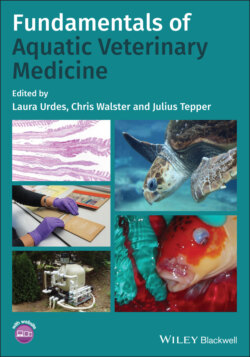Читать книгу Fundamentals of Aquatic Veterinary Medicine - Группа авторов - Страница 48
1.3.3.5 Pests and Predators
ОглавлениеPests and predators are unwanted animals or plants that destroy fish or hinder the production of target fish species. Birds, fish, reptiles, amphibians, mammals and even certain invertebrates are known predators of cultured fish. Bird predation is the major source of fish loss at aquaculture facilities. Tadpoles feed on aquatic plants and animals, while frogs can eat fish fry. They lay eggs on the surface of ponds, which interferes with surface oxygenation, thereby restricting fish growth if not checked. Sea anemones can grow on boards, sluice gates and grooves, and on concrete dikes in high‐salinity, brackish water areas, and are poisonous to fish.
Fish predators can be used in controlling an overpopulation of fish in ponds. Wild fish are one of the potential sources of fish pathogenic organisms. Some of these wild species are predatory in nature and prey upon the young of cultivated species. They can rapidly multiply and compete for food with the cultivated fish. Control of nuisance fish can be done by poisoning or dewatering the pond. Piscicides of plant origin are preferred over common chemical insecticides used in agriculture due to the long‐lasting toxicity and residual effect of the latter. Moreover, fish killed by insecticides become unfit for human and animal consumption. Piscicides derived from plants such as mahua oil cake are most commonly used as their toxicity lasts for about two weeks and the fish killed are fit for human consumption. Mahua oil is applied at 200–250 ppm. However, the poisoning process kills only the unwanted fish species of the pond without affecting the pathogenic organisms they may carry. Disinfection of water is an effective means of disease control in fish culture by reducing the numbers of pathogens to minimum levels.
